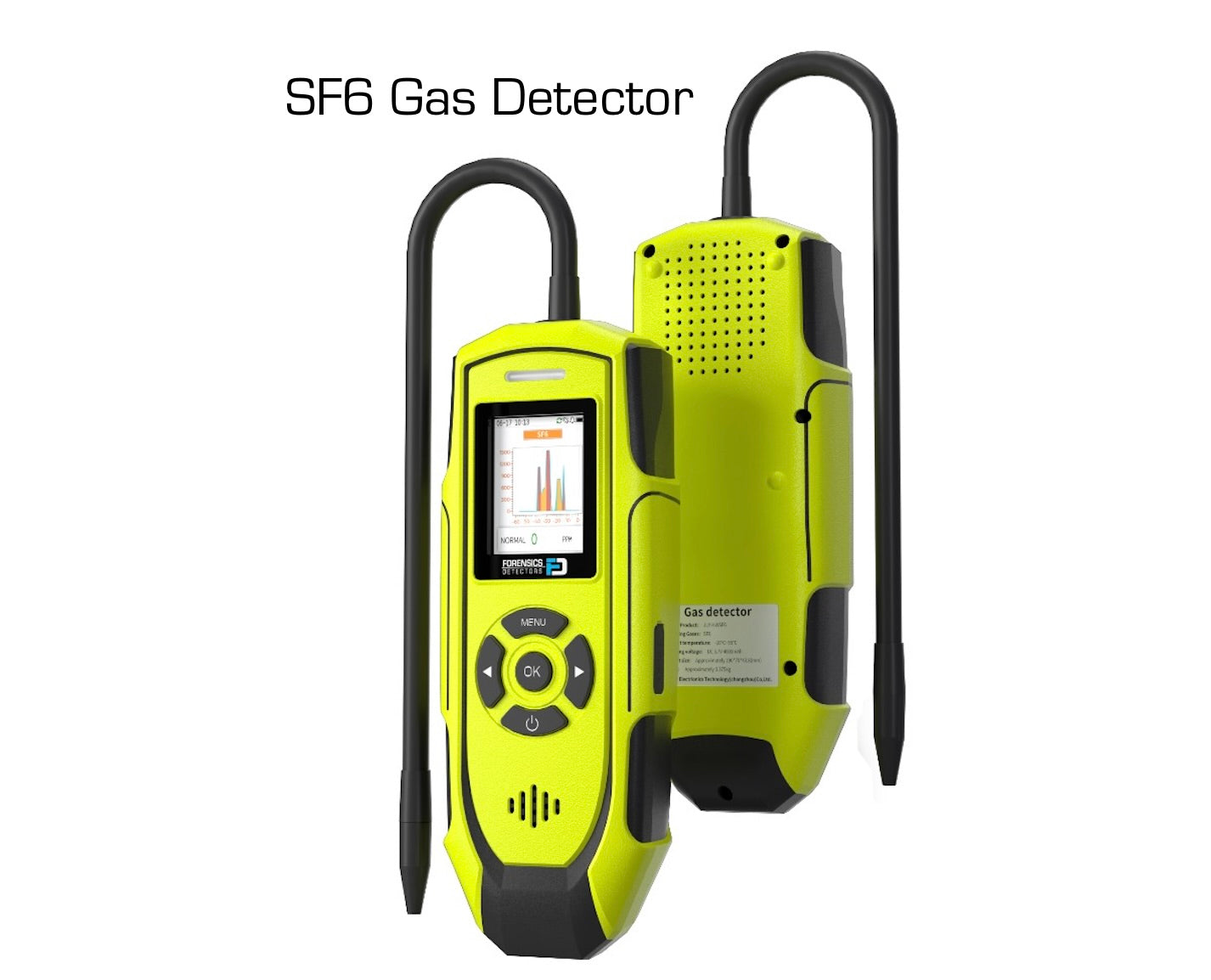Sulfur hexafluoride (SF6) is a colorless, odorless, non-toxic but potent greenhouse gas widely used in electrical equipment as an insulating medium. SF6 gas detectors serve as essential tools for identifying leaks in high-voltage switchgear, circuit breakers, and other electrical equipment where this gas is commonly used. SF6 gas detectors are used in power utilities, electrical substations, and industrial facilities using SF6-insulated equipment.
| Pros | Cons |
|---|---|
| ✅ Detects SF6 leaks | ⛔ Requires regular calibration (typically every 12 months) |
| ✅ SF6 Gas Detectors can operate down to parts per million | ⛔ Requires a maintenance schedule |
| ✅ Advanced SF6 sensor technology using a NDIR cell lasts over 5 years | ⛔ High-sensitivity detectors can be relatively expensive |
| ✅ Prevents equipment failures and costly SF6 replacement | ⛔ Many SF6 leak detector options that can be confusing |
Best SF6 Leak Detector?
- Handheld Sulfur Hexafluoride (SF6) Gas Detector, 0 to 3000 ppm
- Handheld Sf6 Qualitative Leak Detector
- SENSIT Combustible Gas Detector
What is SF6?
Sulfur hexafluoride (SF6) is an inorganic, colorless, odorless, non-flammable, and non-toxic gas. With the chemical formula SF6, it consists of one sulfur atom bonded to six fluorine atoms in an octahedral arrangement. SF6 is primarily known for its exceptional electrical insulating properties, making it invaluable in high-voltage electrical equipment. It has:
- Excellent electrical insulation properties
- Superior arc-quenching capabilities
- Chemical stability and inertness
- Low toxicity (though it can cause asphyxiation by displacing oxygen in confined spaces)
- Thermal stability across a wide range of temperatures
What is an SF6 Gas Detector?
An SF6 detector is a gas monitoring device (also known as a gas detector) designed to detect the presence of sulfur hexafluoride gas in ambient air. The best SF6 detectors employ NDIR sensors that measure SF6 based on its absorption of specific infrared wavelengths. They offer high sensitivity and selectivity, with minimal cross-sensitivity to other gases.
Who Needs an SF6 Detector?
SF6 detectors are essential for various industries and applications:
- Electric Utilities: Power generation, transmission, and distribution companies using SF6 in high-voltage circuit breakers, switchgear, and transformers.
- Industrial Electrical Systems: Manufacturing facilities with SF6-insulated equipment.
- Electrical Equipment Manufacturers: Companies producing or testing SF6-filled equipment.
- Maintenance and Service Technicians: Personnel who service or repair electrical equipment containing SF6.
- Environmental Compliance Teams: Staff responsible for monitoring greenhouse gas emissions and regulatory compliance.
- Research Laboratories: Facilities working with SF6 for various scientific applications.
- Medical Equipment Facilities: Some medical imaging equipment uses SF6 as a contrast agent.
- Military and Aerospace: Certain specialized equipment uses SF6 for insulation purposes.
- Semiconductor Manufacturing: Some processes use SF6 in plasma etching.
Why is SF6 Detection Important?
SF6 detection is crucial for several key reasons:
Environmental Impact
SF6 is one of the most potent greenhouse gases known, with a global warming potential 23,500 times that of CO2 and an atmospheric lifetime of 3,200 years. Even small leaks can have significant long-term environmental impacts, making detection crucial for environmental protection.
Regulatory Compliance
Increasingly strict regulations worldwide require monitoring and reporting of SF6 emissions. In many jurisdictions, companies must maintain detailed records of SF6 inventory, usage, and emissions, with substantial penalties for non-compliance.
Equipment Protection
SF6 leaks reduce the insulating effectiveness of electrical equipment, potentially leading to failures, arcing, and even catastrophic breakdowns. Early detection prevents expensive equipment damage and power outages.
Economic Considerations
SF6 is expensive, and leaks represent a direct financial loss. Additionally, the cost of equipment failure, emergency repairs, and unplanned downtime far exceeds the cost of implementing detection systems.
Safety Concerns
While SF6 itself is non-toxic, it can displace oxygen in confined spaces, potentially creating an asphyxiation hazard. In electrical failures, SF6 can also decompose into toxic byproducts that pose health risks to workers.
How Often Should SF6 Detectors Be Calibrated?
Most manufacturers recommend calibrating SF6 detectors every 12 months.
What is the Minimum Detection Limit for SF6 Detectors?
Quality SF6 detectors typically detect concentrations as low as 1 ppm.
How to Select the Best SF6 Gas Leakage Detector?
When selecting an SF6 gas leakage detector, consider several key factors: required sensitivity (most applications need at least 1 ppm detection capability), portability requirements, power source (battery life for field use), environmental conditions where it will operate, ease of operation, maintenance requirements, and available budget.
How Do Fluke TI450 SF6 Gas Detector and Other Thermal Imaging Detectors Compare?
Thermal imaging SF6 detectors like the Fluke TI450 SF6 use infrared technology to visually identify SF6 leaks by displaying them as colored clouds on a screen. These systems offer advantages including no direct contact required with equipment, ability to detect leaks at a distance (up to 10 meters), and visual documentation of leak locations. Compared to traditional sniffers, the Fluke TI450 SF6 gas detector provides excellent visualization but typically has higher minimum detection limits (around 0.5-1.0 g/year).
What's the Difference Between Fixed and Portable SF6 Detectors?
Fixed SF6 detectors are permanently installed in facilities for continuous monitoring, often integrated with building management systems to trigger automatic alarms or ventilation responses. They provide 24/7 protection but monitor only specific locations. Portable detectors are handheld or wearable devices used for maintenance inspections, leak surveys, and verification of repairs. They offer flexibility to check various equipment components, but require active operation by personnel.
Some Facts About SF6 Gas Detectors:
✅ SF6 gas detectors are specialized instruments designed to measure and monitor concentrations of sulfur hexafluoride gas in electrical equipment and surrounding environments.
✅ SF6 detectors typically utilize infrared technology, negative ion capture, or ultrasonic sensors for accurate measurement at parts per million (ppm) levels.
✅ Professional-grade SF6 detectors offer features like real-time monitoring, multiple alarm systems, and data logging capabilities for environmental compliance documentation.
✅ Detection equipment ranges from portable leak detectors for maintenance teams to fixed installation systems for continuous monitoring of critical electrical infrastructure.
What are SF6 Regulatory Requirements?
Sulfur hexafluoride (SF6) is subject to increasingly strict regulations worldwide due to its extreme global warming potential:
United States: The EPA requires reporting of SF6 emissions under the Greenhouse Gas Reporting Program (40 CFR Part 98, Subpart DD) for facilities with nameplate capacity exceeding 17,820 pounds (8,084 kg) of SF6. Many states have implemented additional requirements, with California leading through its stricter SF6 phase-out regulations.
European Union: The F-Gas Regulation (EU No 517/2014) mandates strict SF6 management practices, including leak detection, record-keeping, and emission reduction. The EU is implementing a gradual phase-down of SF6 use in many applications.
International: The Kyoto Protocol and Paris Agreement identify SF6 as a regulated greenhouse gas, with many countries implementing national regulations to reduce emissions.
Final Word
The selection of a reliable SF6 detector remains crucial for maintaining environmental compliance, protecting valuable electrical equipment, and preventing unnecessary emissions of this potent greenhouse gas. Professional-grade detection equipment, featuring accurate sensors and comprehensive alarm systems, provides the necessary tools for effective SF6 management programs. Regular maintenance, proper calibration, and trained personnel ensure these detectors deliver optimal performance, making them an indispensable tool in modern electrical infrastructure management. As regulations continue to tighten around SF6 usage, comprehensive detection systems represent both an environmental responsibility and a sound business investment.
About the Author
Dr. Kos Galatsis ("Dr.Koz") is the President of FORENSICS DETECTORS, where the company operates from the scenic Palos Verdes Peninsula in Los Angeles, California. He is a subject matter expert on gas sensor technology, gas detectors, gas meters, and gas analyzers. He has been designing, building, manufacturing and testing toxic gas detection systems for over 20 years.

Every day is a blessing for Dr. Koz. He loves to help customers solve their unique problems. Dr. Koz also loves spending time with his wife and his three children going to the beach, grilling burgers, and enjoying the outdoors.
Read more about Forensics Detectors here.
Email: drkoz@forensicsdetectors.com

